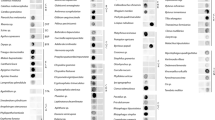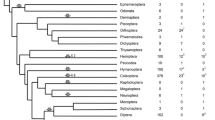Telomere-associated repeats in Chironomus form discrete subfamilies generated by gene conversion (original) (raw)
- 56 Accesses
- 35 Citations
- Explore all metrics
Summary
In dipteran insects the most distal telomere-associated DNA known to exist consists of long, complex tandem repeats. We have classified the 340-bp tandemly arranged repeats in Chironomus pallidivittatus. The repeats are distributed in a small number of subfamilies. One type of the repeat has the character of a master unit from which other main units can be derived usually by simple changes. The derived subfamilies contain segments that are degenerate versions of the corresponding segment in the master sequence. Such segments can also occur together in one and the same repeat unit in different combinations. There is a complete absence of subfamily-specific base variants in regions lying outside of the degenerate segments. Homogenization takes place between DNA sequences that are often smaller than a whole repeat unit. The mosaic structure of the repeat arrays suggests that gene conversion is an important force in the generation and maintenance of this family of repeats.
Access this article
Subscribe and save
- Get 10 units per month
- Download Article/Chapter or eBook
- 1 Unit = 1 Article or 1 Chapter
- Cancel anytime Subscribe now
Buy Now
Price excludes VAT (USA)
Tax calculation will be finalised during checkout.
Instant access to the full article PDF.
Similar content being viewed by others


Telomerase lost?
Article 11 July 2015
References
- Bachmann L, Raab M, Sperlich D (1990) Evolution of a telomore associated satellite DNA sequence in the genome of Drosophila tristis and related species. Genetica 83:9–16
Google Scholar - Bauer H (1936) Beiträge zur vergleichenden Morphologie der Speicheldrüsenchromosomen (Untersuchungen an den Riesenchromosomen der Dipteren. II). Zool Jahrb (Physiol) 56: 239–276
Google Scholar - Beermann W (1955) Cytologische Analyse eines Camptochironomus-Artbastards. I. Kreuzungsergebnisse and die Evolution des Karyotypus. Chromosoma 7:198–259
Google Scholar - Blackburn EH (1991) Structure and function oftelomeres. Nature 350:569–573
Google Scholar - Botella LM, Morcillo G, Barettino D, Diez JL (1991) Heatshock induction and cytoplasmic localization of transcripts from telomeric-associated sequences in Chironomus thummi. Exp Cell Res 196:206–209
Google Scholar - Carmona MJ, Morcillo G, Galler R, Martinez-Salas E, de la Campa AG, Diez JL, Edström J-E (1985) Cloning and molecular characterization of a telomeric sequence from a temperature-induced Balbiani ring. Chromosoma 92:108–115
Google Scholar - Chen EY, Seeburg PH (1985) Supercoil sequencing: a fast and simple method for sequencing plasmid DNA. DNA 4:165–170
Google Scholar - Cohn M, Edström J-E (1991) Evolutionary relations between subtypes of telomere-associated repeats in Chironomus. J Mol Evol 32:463–468
Google Scholar - Deveraux J, Haeberli P, Smithies O (1984) A comprehensive set of sequence analysis programs for the VAX. Nucleic Acids Res 12:387–395
Google Scholar - Dover GA (1987) DNA turnover and the molecular clock. J Mol Evol 26:47–58
Google Scholar - Hillis DM, Moritz C, Porter CA, Baker RJ (1991) Evidence for biased gene conversion in concerted evolution of ribosomal DNA. Science 251:308–310
Google Scholar - Hinton T (1945) A study of chromosome ends in salivary gland nuclei of Drosophila. Biol Bull 88:144–165
Google Scholar - Hughes AL, Nei M (1989) Nucleotide substitution at major histocompatibility complex class II loci: evidence for overdominant selection. Proc Natl Acad Sci USA 86:958–962
Google Scholar - Jeffreys AJ, Neumann R, Wilson V (1990) Repeat unit sequence variation in minisatellites: a novel source of DNA polymorphism for studying variation and mutation by single molecule analysis. Cell 60:473–485
Google Scholar - Maniatis T, Fritsch EF, Sambrook J (1982) Molecular cloning: a laboratory manual. Cold Spring Harbor University Press, Cold Spring Harbor NY.
Google Scholar - Miyata T, Yasunaga T (1981) Rapidly evolving mouse α-globin-related pseudogene and its evolutionary history. Proc Natl Acad Sci USA 78:450–453
Google Scholar - Morin GB, Cech TR (1988) Mitochondrial telomeres: surprising diversity of repeated telomeric DNA sequences among six species of Tetrahymena. Cell 52:367–374
Google Scholar - Nielsen L, Schmidt ER, Edstrom J-E (1990) Subrepeats result from regional sequence conservation in tandem repeats in Chironomus telomeres. J Mol Biol 216:577–584
Google Scholar - Renkawitz-Pohl R, Bialojan S (1984) A DNA sequence of Drosophila melanogaster with a differential telomeric distribution. Chromosoma 89:206–211
Google Scholar - Rubin GM (1978) Isolation of a telomeric DNA sequence from Drosophila melanogaster. Cold Spring Harbor Symp Quant Biol 42:1041–1046
Google Scholar - Saiga H, Edstrom J-E (1985) Long tandem arrays of complex repeat units in Chironomus telomeres. EMBO 14:799–804
Google Scholar - Strachan T, Sodoyer R, Damotte M, Jordan BR (1984) Complete nucleotide sequence of a functional class I HLA gene, HLA-A3: implications for the evolution of HLA genes. EMBO J 3:887–894
Google Scholar - Strachan T, Webb D, Dover GA (1985) Transition stages of molecular drive in multiple-copy DNA families in Drosoph-ila. EMBO J 4:1701–1708
Google Scholar - Traverse KL, Pardue ML (1989) Studies of He-T DNA sequences in the pericentric regions of Drosophila chromosomes. Chromosoma 97:261–271
Google Scholar - Warters M, Griffen AB (1950) The telomeres of Drosophila. J Hered 41:182–195
Google Scholar - Weiss EH, Mellor A, Golden L, Fahmer K, Simpson E, Hurst J, Flavell RA (1983) The structure of a mutant H-2 gene suggests that the generation of polymorphism in H-2 genes may occur by gene conversion-like events. Nature 301:671–674
Google Scholar - Willard HF, Waye JS (1987) Hierarchical order in chromosome-specific human alpha satellite DNA. Trends Genet 3: 192–198
Google Scholar - Young BS, Pession A, Traverse KL, French C, Pardue ML (1983) Telomere regions in Drosophila share complex DNA sequences with pericentric heterochromatin. Cell 34:85–94
Google Scholar
Author information
Authors and Affiliations
- Department of Molecular Genetics, University of Lund, S-22362, Sölvegatan 29, Lund, Sweden
Marita Cohn & Jan-Erik Edström
Authors
- Marita Cohn
You can also search for this author inPubMed Google Scholar - Jan-Erik Edström
You can also search for this author inPubMed Google Scholar
Additional information
O_ffprint requests to:_ M. Cohn
Rights and permissions
About this article
Cite this article
Cohn, M., Edström, JE. Telomere-associated repeats in Chironomus form discrete subfamilies generated by gene conversion.J Mol Evol 35, 114–122 (1992). https://doi.org/10.1007/BF00183222
- Received: 03 February 1992
- Revised: 17 March 1992
- Issue Date: August 1992
- DOI: https://doi.org/10.1007/BF00183222
